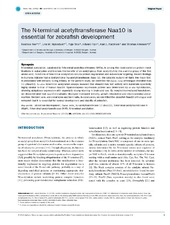The N-terminal acetyltransferase Naa10 is essential for zebrafish development
Ree, Rasmus Moen; Myklebust, Line Merethe; Thiel, Puja; Foyn, Håvard; Fladmark, Kari Espolin; Arnesen, Thomas
Peer reviewed, Journal article
Published version

View/
Date
2015-08-06Metadata
Show full item recordCollections
Original version
https://doi.org/10.1042/bsr20150168Abstract
N-terminal acetylation, catalysed by N-terminal acetyltransferases (NATs), is among the most common protein modifications in eukaryotes and involves the transfer of an acetyl group from acetyl-CoA to the α-amino group of the first amino acid. Functions of N-terminal acetylation include protein degradation and sub-cellular targeting. Recent findings in humans indicate that a dysfunctional Nα-acetyltransferase (Naa) 10, the catalytic subunit of NatA, the major NAT, is associated with lethality during infancy. In the present study, we identified the Danio rerio orthologue zebrafish Naa 10 (zNaa10). In vitro N-terminal acetylation assays revealed that zNaa10 has NAT activity with substrate specificity highly similar to that of human Naa10. Spatiotemporal expression pattern was determined by in situ hybridization, showing ubiquitous expression with especially strong staining in brain and eye. By morpholino-mediated knockdown, we demonstrated that naa10 morphants displayed increased lethality, growth retardation and developmental abnormalities like bent axis, abnormal eyes and bent tails. In conclusion, we identified the zebrafish Naa10 orthologue and revealed that it is essential for normal development and viability of zebrafish.
